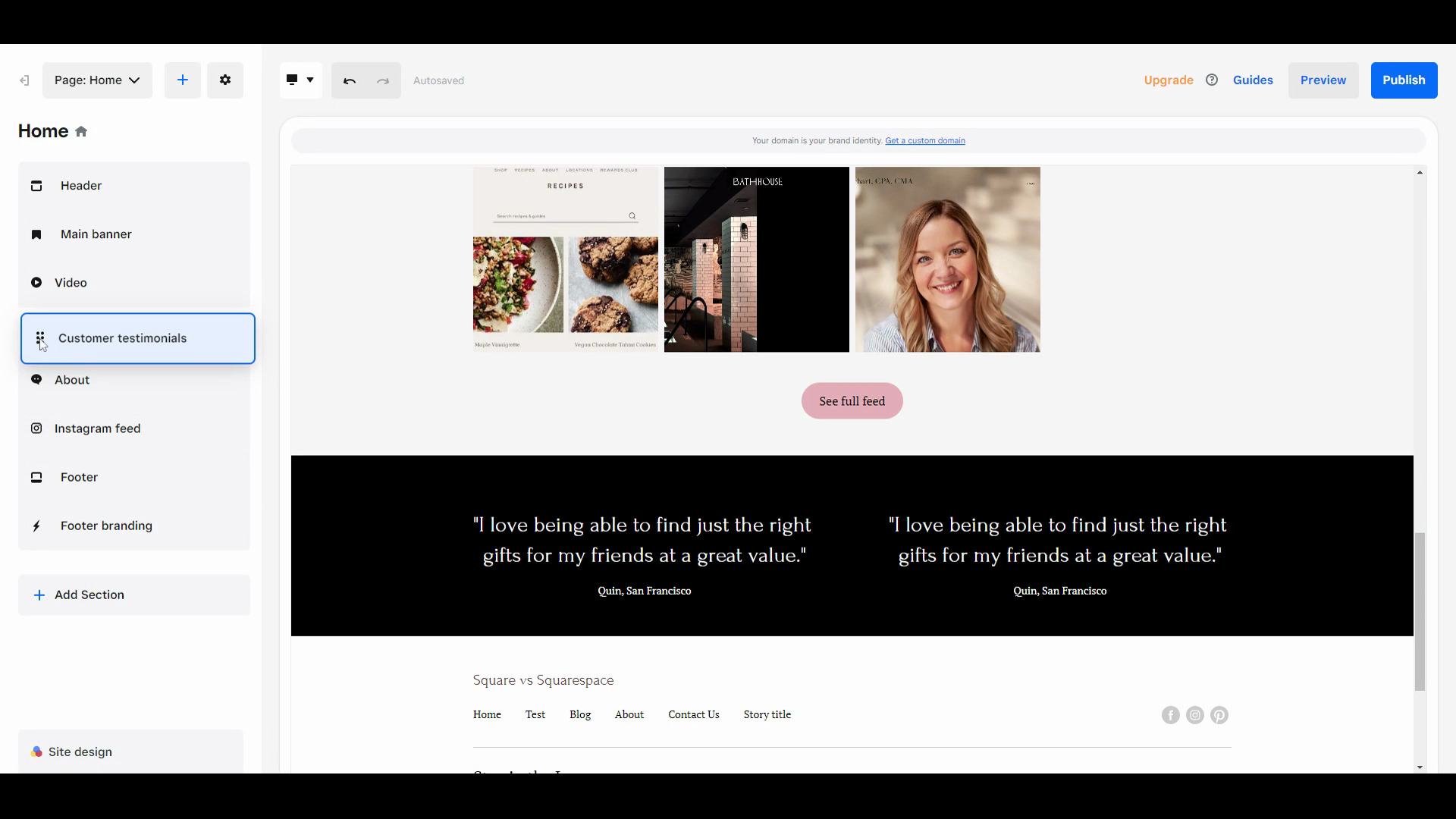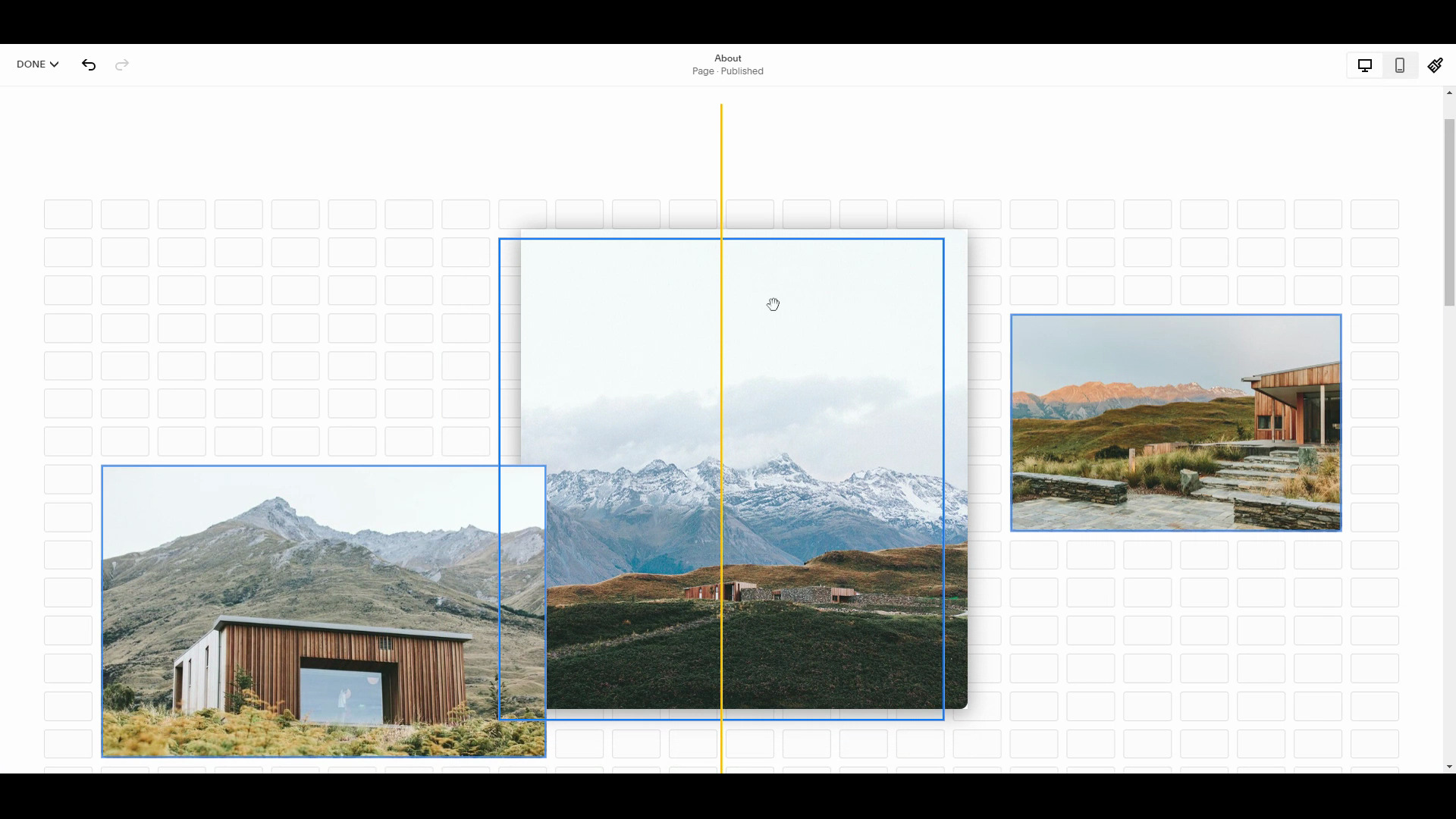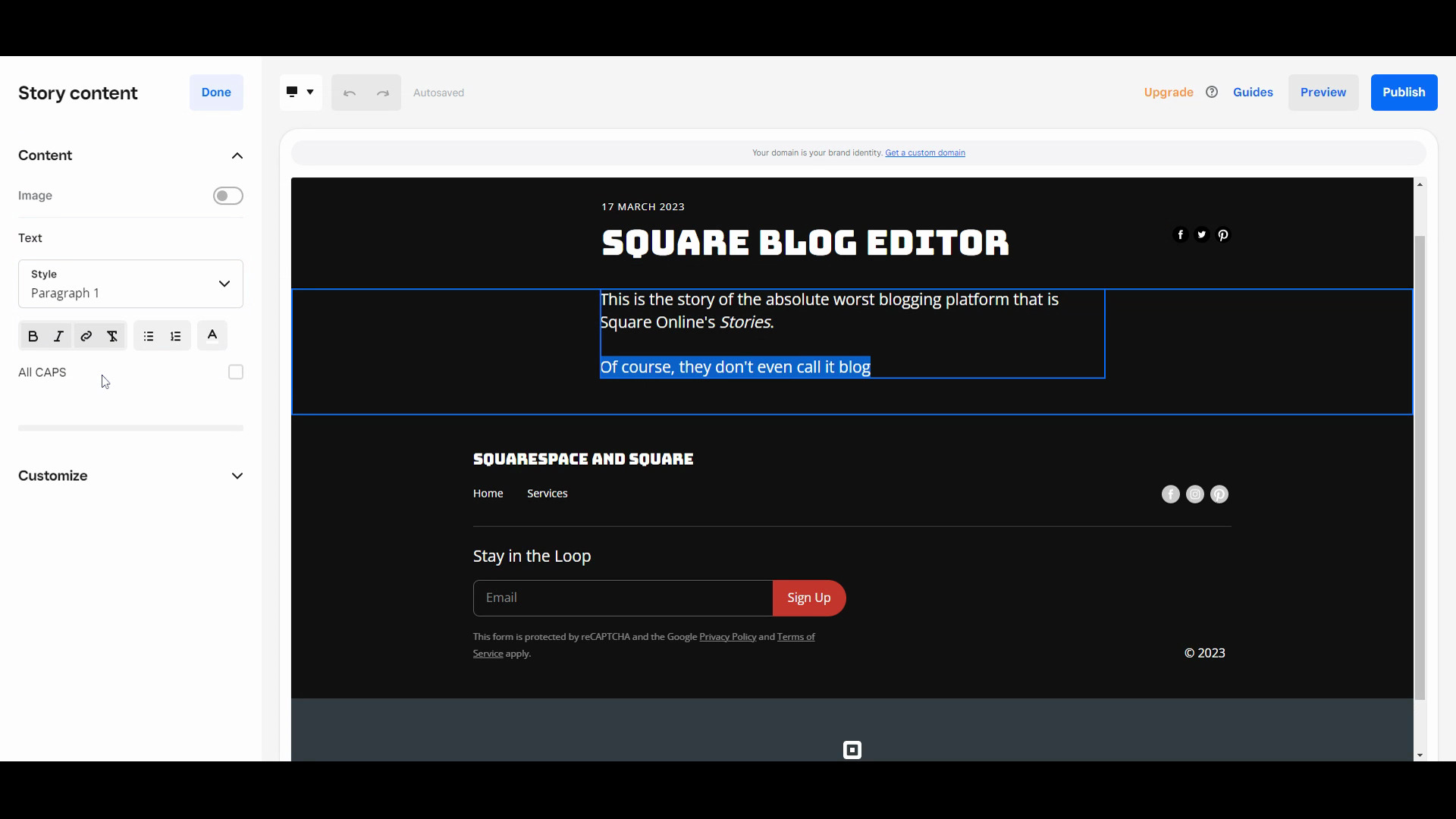Best Website Builder
I test every website builder so you don’t have to. These are my rankings of the best website builders in 2025.
Our work is supported by affiliate commissions. Learn More
By Juhil Mendpara | Updated Jan 3 2025
Squarespace is like the iPhone of website builders: It’s polished and has almost all the features you’ll need — i.e., it just works.
Square Online is more like a modern feature phone: It has basic functionalities that work well, and that’s about it.
Like the iPhone and a feature phone, both Squarespace and Square Online have their place in the market — though most people will (and should) choose Squarespace.
Their difference is almost like iPhone (Squarespace) vs Feature phone (Square): Whatever Square Online can do, Squarespace can. But many things Squarespace can do aren’t possible with Square Online.
Square’s editor is very easy to use but also very basic. Squarespace’s editor has a slight learning curve but is A LOT MORE CUSTOMIZABLE.
All Square templates are just different, bland versions of the same layout. Squarespace offers 150+ best-in-the-market templates.
Square is unusable for a serious blog. Squarespace offers the best blogging of all DIY website builders.
For restaurants and retail store owners using Square’s POS system and/or other Square commerce solutions, Square Online is a good option for basic ecommerce. Squarespace is an overall superior ecommerce platform.
Square Online is a bit cheaper, but Squarespace offers better value for money.
The biggest difference between Square and Squarespace is the page editor.
Square Online’s editor is easier to use but too simple. In contrast, Squarespace has a much more customizable and intuitive editor, but there’s a slight learning curve.
[Fun fact: Square Online and Squarespace are the top two names on our easiest website builders list]

Square divides its editor into pre-defined sections, each with (basic) pre-defined layouts.
For example, there are sections like Text, Instagram feed, Text and image, Forms, Location, Email newsletter, etc. And each section has a few different layouts (some have more than others) — for example, these are for the Text and image section:

Layouts of Square Online’s Text and image section. Each layout is a different arrangement of text and image.
You make your Square website by adding and arranging such sections (with your choice of layouts). For instance, here’s me adding, editing, and placing a couple of sections using the Square Online editor:

A peek into Square Online editor.
In addition to choosing the layout, you can also select a section color from your site color palette; align the text left, right, or center; and turn on/off some of the section elements.
This cookie-cutter approach to website building makes Square Online very easy to use.
You can’t make anything even slightly unique with Square Online. For example, here’s a part of a photography website made with Squarespace:

The images are randomly yet beautifully arranged.
There’s no way to do this (or thousands of different variations of this) with Square because you can only choose from six pre-defined _Gallery _layouts.
In fact, you can’t even do some simpler-yet-essential things like quickly adding text to your Square website. To add text, you have to add a new Text section. And the Text section has two layout choices—both with a title and a description. So if you want a heading text, you’ll have to turn off the description, align the title, and format it as needed. That’s frustrating!
Overall, you can make simple websites quickly with Square Online. However, you’ll be confined by Square’s editor if you want a unique website.
You won’t encounter the same problems with Squarespace because it has a customizable drag-and-drop editor.
You start building a Squarespace page like you make a Square Online page — i.e., by adding sections and choosing a suitable layout for each section.
And then the Squarespace editor — Fluid Engine — comes in.
Fluid Engine allows you to drag elements (called Content Blocks) into rows and columns of a section. Squarespace has Content Blocks like text, image, form, newsletter, map, menu, etc., that you can play with inside the section. [Fact: Squarespace has more content blocks and section options than Square Online]
For example, here’s me adding an Images section, moving image blocks, and adding a text block:

A peek into Squarespace’s Fluid Engine editor.
You can’t do this simple moving and adding part with Square Online.
Squarespace manages to give comparatively more control over site style without being overwhelming. You can do things like:
Despite this flexibility of the Squarespace editor, Squarespace is easy to use because it is structured and well-designed/intuitive. (For contrast, check Wix’s editor compared to Squarespace)
Overall, Squarespace gives the best customizability to ease-of-use balance of any website builder. Square Online is a bit easier to use but gives very little room for customization.
Good templates help build good websites fast. They just need some site style changes and content swapped out to become publishable websites.
In this sense, templates are central to a website builder’s “ease of use” factor.
How do both website builders compare on the “templates” front? There’s one cleaaaaaaaar winner.
Square Online doesn’t even do the bare minimum with its templates. There’s just one layout and different styles of that layout (simple color and font changes) to choose from.

Square template styles
Though it’s simple to do, you’ll be responsible for building pretty much the whole website from scratch.
Squarespace has the best templates of any website builder.
We have lists of Squarespace templates for many different types of websites. Here are a few examples:
Ortiz template for personal/photography/portfolio websites:

Rey template for wedding websites:

Emmeline template for salon/services/ecommerce websites:

Any random Squarespace template will beat everything Square Online offers on the “templates” front. It’s not even a competition — Squarespace is the cleaaaaaaaar winner!
Now we are in Square Online’s (and Square’s in general) home ground: Commerce.
Square Online is pitched as an online store builder, and the website builder is a part of it. On the other hand, Squarespace is primarily a website builder that also has ecommerce functionalities.
Here’s how their ecommerce features compare:
Both Squarespace and Square offer similar shipping options: They allow you to set free shipping, flat rate shipping, local pickup, local delivery, location-based shipping, weight-based shipping, and product price-based shipping for all regions.
Plus, you can set real-time shipping rates based on FedEx, UPS, and USPS carrier charges on both; Square has an extra DHL option.
You can even fulfill your orders through third-party fulfillment companies. Squarespace and Square integrate with top 3PL providers like ShipBob, ShipStation, Shippo, etc.
Contrary to what many comparisons on the internet suggest, I didn’t find Square Online’s inventory management features better than Squarespace’s.
Both have similar features: You can add SKUs and stock quantity, and both platforms automatically update the quantity when sales come in. Also, you can add/remove/update your stock.
Though there are a couple of differences:

There are two other differences, but they have more to do with the core ecommerce platforms than inventory management features:
Both Squarespace and Square offer very limited payment options, though you can accept most major payment methods with both.
Both Square and Squarespace offer automatic tax collection features in the US. Square has its own system, whereas Squarespace gives free access to TaxJar—a modern sales tax compliance system.
A product editor is where you add information that shows up on your product page or helps with product organization.
Both Squarespace and Square Online cover the basics: You can add the product name, product description, product images, price (MRP and sale price), product variants (size, color, etc.), SKUs, shipping details (like weight and dimensions), and basic SEO details (permalink, SEO Title, and SEO Description) with their product editors.
But beyond that, Squarespace has a better, more streamlined product editor than Square Online — you can add more detailed product and product organization information with Squarespace:

Squarespace Product Options

Square product variations


Products you can sell on Square
On Square, you can sell physical products, event tickets, digital downloads, services/appointments, donations, and membership.
Squarespace allows you to sell everything Square does, plus you can sell on-demand videos and online courses as well.

Products you can sell on Squarespace
Both Squarespace and Square have ecommerce tools for restaurants.
Tock from Squarespace focuses on reservation management, prepaid experiences, and online ordering. It includes CRM, guest profiles, and marketing and analytics tools.
On the other hand, Square for Restaurants provides a comprehensive POS system, online ordering with delivery integration, employee management, CRM, KDS (Kitchen Display System), and robust reporting and analytics.
Overall, Square for Restaurants is a well-rounded restaurant tool compared to Squarespace’s Tock, which only excels at reservation and operations management
A sales channel is where you sell your products or services, directly or indirectly.
For example, your ecommerce store is one sales channel (likely your primary channel).
Similarly, Squarespace and Square both offer integration with three other popular sales channels - Facebook, Instagram, and Google Shopping. These integrations sync your catalogs to the respective platforms, allowing you to expand reach, engage with customers, and drive sales more effectively.
Though both offer the same sales channels, Square is inferior because the Google Listings feature is only available for Food and Drink sites.
Square is a good option for restaurants and retail stores that want to come online. However, Squarespace has better overall ecommerce features, including better inventory management, product editor, and sales channels.
Squarespace has the best blogging of any website builder. It has all the blogging features you’d need, including:
Also, the Squarespace blog editor is very comprehensive — you can add galleries, newsletter forms, scrolling, event tickets, restaurant menus, Instagram feeds, and more to your blog posts.
On the other hand, Square Online has perhaps the worst blogging features.
Square’s blog platform is called Stories. And it barely covers any blogging features. For example, you can’t even allow reader comments.
Plus, the Story page editor is as basic as it gets. You can have a title (Story header), a cover image, and simple text (Story content) — that’s it. If you try to format a part of the Story content, the formatting applies to the whole of it. For instance, here’s me trying to convent simple paragraph into a heading:

The formatting applies throughout the Story content.
Squarespace has the best blogging of all DIY website builders. In comparison, Square Online doesn’t even cover the basics.
Squarespace and Square Online offer various marketing tools to help users effectively promote products or services.

Also, Squarespace Email Campaign templates are nice and easy to edit. And you can match the design elements of your emails with your website.
Like its blogging features or sales channels, other Square Online marketing features are basic compared to Squarespace’s. For example, Square’s email marketing templates and editor are inferior to Squarespace’s Email Campaigns. Square has the benefit of having some additional features like text marketing, though.
Note: Some of the marketing features on both platforms cost extra.
Both Squarespace and Square offer essential marketing features, but Squarespace excels at their quality.
Technically, due to its simplicity, Square Online-made websites should load faster than Squarespace websites.
But, in reality, Squarespace-made websites perform WAY BETTER!
According to an ongoing CWV Report that tracks core web vitals (an industry-standard page performance metric) of different website builders, over 50% of Squarespace and Squarespace Commerce websites pass the CWV test compared to only 0.5% of Square Online 😲.

I couldn’t believe it, so I made two simple, similar-looking photography web pages with Square Online and Squarespace. I didn’t do any speed optimization and ran both through GTmetrix, a web performance testing tool.
Sure enough, Squarespace passed the performance test with an ‘A’ grade, and the Square Online website scored a ‘D’ grade.

GTmetrix score of a Square Online-made website.

GTmetrix score of a Squarespace-built website.
Squarespace websites load faster and perform better than Square Online websites.
Both Squarespace and Square Online prioritize security to protect users’ and their customers’ data.
Squarespace has a strong security track record with no reported cases of hacked websites. They ensure protection by adding SSL certificates, allowing & promoting two-factor authentication for login, hashing passwords, and utilizing secure data centers. Additionally, they encourage security researchers to report vulnerabilities for bounties.
Square Online, as an e-commerce platform, focuses on providing a secure environment for users and their customers. They are ISO 27001 certified, indicating a high level of security standards in their systems. They also offer SSL certificates for all sites built on their platform, ensuring encrypted data transfer. Square Online incorporates secure user authentication methods and utilizes reputable data centers and cloud providers to maintain the security of its platform.
Your site will be secure with either platform.
Square Online provides phone support, a live chat option, and email support. The support team’s hours of operation are 6 AM - 6 PM PST Mon-Fri and 8 AM - 5 PM Sat/Sun. However, Square Online’s Premium plan users can access 24/7 phone support in English.
I tried their live chat, but it’s more of a chatbot than a human answering you.
Then, I sent a simple question regarding domain transfer to Square Online email support. The response time was pretty good on the weekdays and bad on weekends. But the response quality was the worst:
Squarespace offers 24/7 email support and live chat during weekdays. I got immediately connected to an actual human on their live chat and got responses in under half an hour from their email support.
Squarespace support team responds faster and with better answers than Square Online support.
Square has a free plan and a cheaper ecommerce starter plan, but Squarespace offers better value for money overall. Here’s how the plans compare:

Squarespace offers a 14-day free trial. Post that, you can choose one of these plans (prices mentioned are for the annual plan):
Square Online doesn’t have a free trial but has the best free plan of any website builder. Its paid plans are a bit weirdly represented. If you look at the pricing page on the website, you’ll see three plans - Free, Plus, and Premium:

However, when you sign up with Square Online and try to upgrade, there’s an extra Professional plan that essentially removes the Square branding from the free plan.

The main three plans are:
Since Squarespace is a superior platform and the plan pricing isn’t much different (in fact, Squarespace’s higher tier plans are cheaper), Squarespace wins the value-for-money round.
Square acquired the popular website builder Weebly in 2018 and has since used the Weebly platform’s features in the Square Online website builder.
It seems like the sync between Square and Weebly isn’t perfect. Ideally, you shouldn’t even see Weebly’s name when working on the Square Online platform, but not only do you see Weebly’s name, many of the tasks are seemingly performed on Weebly and then synced to the Square Online site. And that’s not the worst part! I faced many errors because of imperfect syncing — which is frustrating, to say the least.

The site kept loading.

Sync error.

Another sync error
Here’s a related prominent fact that might help make the already easy decision of choosing between Squarespace and Square easier: Square hasn’t treated Weebly users well. Weebly users must either move to the new Square editor, or their website will be stuck on the Weebly editor — a dying platform. I think that’s pretty user-hostile.
As a user, it’s worth asking yourself: do you want to be partnered with Square — a company that just buys Weebly and forces its users to migrate to a new editor?
Squarespace beats Square Online at almost everything, from customizability to performance and from ecommerce to value for money.
Between the two, Squarespace is the easy choice.
Square Online is only good for restaurants and retail store owners who already use Square’s other services and want a simple website/ecommerce store.


